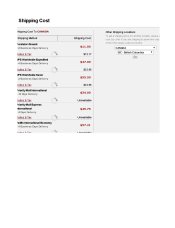I've been thinking about what is available "off the shelf" in the world of developers, and started wondering about one possibility - is there any way to make a pre-packaged powder print developer that one could mix up into a highly concentrated (something like 1+7 or 1+19) stock solution, a litre at a time.
First some background.
I, like many others, have limited storage and working space, and do darkroom work in batches.
I do not have any space available to dedicate to storage of quantities of chemicals, and with the space available I really don't forsee being able to mix up my own from scratch.
As I am in Canada, it can also be more difficult to get many things shipped, although in my case I can have some things shipped to a US address.
I am quite comfortable with mixing up chemicals from pre-packaged powders.
My favourite working volume is two litres at a time.
Right now, I am using Kodak PolyMax T as my print developer, but its continuing availability is uncertain, and shipping to Canada is prohibitive. When I cannot reliably get it any more, I expect that I would look either to Liquidol or 130 Paper Developer, but Liquidol has the same or similar shipping challenges, and my preference for mixing up 2 litres at a time means that I'm forced to either pay a lot for many small packages of the 130 or mix up up a large quantity of the stock solution at a time (I don't really have the space).
A perfect solution would be a package of powder that is easy to mix to a litre of concentrated stock that might give me 4 - 10 printing sessions.
It might be possible for me to obtain something like TEA in 1 litre quantities, if mixing powders into that might solve the problem.
I could forsee this being useful with film developers and fixers too.
First some background.
I, like many others, have limited storage and working space, and do darkroom work in batches.
I do not have any space available to dedicate to storage of quantities of chemicals, and with the space available I really don't forsee being able to mix up my own from scratch.
As I am in Canada, it can also be more difficult to get many things shipped, although in my case I can have some things shipped to a US address.
I am quite comfortable with mixing up chemicals from pre-packaged powders.
My favourite working volume is two litres at a time.
Right now, I am using Kodak PolyMax T as my print developer, but its continuing availability is uncertain, and shipping to Canada is prohibitive. When I cannot reliably get it any more, I expect that I would look either to Liquidol or 130 Paper Developer, but Liquidol has the same or similar shipping challenges, and my preference for mixing up 2 litres at a time means that I'm forced to either pay a lot for many small packages of the 130 or mix up up a large quantity of the stock solution at a time (I don't really have the space).
A perfect solution would be a package of powder that is easy to mix to a litre of concentrated stock that might give me 4 - 10 printing sessions.
It might be possible for me to obtain something like TEA in 1 litre quantities, if mixing powders into that might solve the problem.
I could forsee this being useful with film developers and fixers too.













